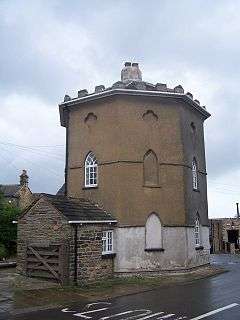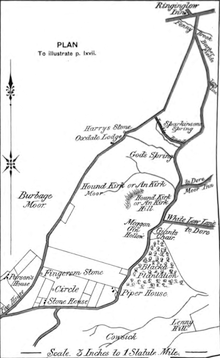Ringinglow
Ringinglow is a village in the western section of Sheffield, England. It is on the western border of Ecclesall Ward, and although it is within the boundary of Sheffield, it is self-contained, being entirely surrounded by open countryside. The village now falls within the Fulwood ward of the City.
| Ringinglow | |
|---|---|
 The Roundhouse | |
 Ringinglow Location within Sheffield | |
| Metropolitan borough | |
| Metropolitan county | |
| Region | |
| Country | England |
| Sovereign state | United Kingdom |
| Post town | Sheffield |
| Postcode district | S11 |
| Dialling code | 0114 |
| Police | South Yorkshire |
| Fire | South Yorkshire |
| Ambulance | Yorkshire |
| UK Parliament | |
The village is focussed on the intersections of Fulwood Lane and Sheephill Road (historically this section was known as Houndkirk Road) with Ringinglow Road. The sources of the Porter Brook and Limb Brook, both tributaries of the River Sheaf, are near the village. The Norfolk Arms, a pub in the village, is often used as a staging-post by ramblers following one of these rivers out of Sheffield towards the Peak District National Park, the eastern boundary of which runs through the village.
History
On Fulwood Lane a polished Neolithic stone axehead was found in 1952 indicating ancient human activity in the area.[1]
An interim report by University of Sheffield staff on excavations of a linear feature in the Sheephill Road, Ringinglow area has suggested evidence of the route of the lost Roman Road linking Templeborough with the Roman Signal Station at Navio (Brough-on-Noe) and Batham Gate. The feature, which extends through Barber Fields is 20m wide and filled to a depth of 5m with rubble and has a metalled surface.[2] This route would have passed close to the Roman Villa at Whirlow Hall Farm.[3]
Historically, the Limb Brook marked the boundary between the Saxon kingdoms of Mercia and Northumbria. This remained the boundary between Yorkshire and Derbyshire into the 20th century. A report dating from 1574 detailed a tour by George Talbot, the 6th Earl of Shrewsbury, then lord of the manor of Sheffield, of the boundaries of the manor, in which they visited 'a great heape of stones called Ringinglawe' that was used as one of the boundary markers.[4] The site of the cairn is believed to be to the west of the village.[5] Sheffield historian S. O. Addy, writing in 1888, noted that the Old English word hlâw is almost always used to refer to a burial mound, and speculated that this 'great heap of stones' may have been an ancient barrow. He further suggested that the etymology of the name Ringinglow suggests that 'originally the heap may have been a round burial mound, or mound surrounded by a circle'.[6] Addy additionally noted that there existed a 'folk etymology' for the name Ringinglow[7]—a story also recounted by local historian J. Edward Vickers[8]—that the village got its name after a man lost on the moors in bad weather was saved when he heard the bells of Sheffield parish church 'ringing low' over the moors. Both authors state that this story is a myth.

Ringinglow Road was constructed as part of a turnpike road from Sheffield to Chapel-en-le-Frith and Buxton that opened in 1758.[9][10] The Grade II listed[11] octagonal former toll house built c. 1778 still stands in the village along with the Norfolk Arms Public House, a coaching inn (also Grade II listed) that was built c. 1840.[12] Addy's 1888 map shows the Norfolk Arms was then known as the Ringinglow Inn.
Historical evidence of shallow coal drift-mining of the Ringinglow seam has been found in the nearby Barber Fields, adjacent to Sheephill Road. This was served by an industrial railway which ran from a location near to Furnace Farm to Copperas Farm. Neither of the farm names appear on the modern Ordnance Survey maps although evidence of a ballasted footpath from the Limb Brook to Smeltings Farm can still be found. The railway is known to have existed in the late 1940s but, like the mines is no more. Other mines in the area were the Deep Sick Coal Pits.[13]
In 2005 a Rotary Club funded toposcope, Finder Cairn, was erected at the junction of Fulwood Lane and Greenhouse Lane.[14][15]
References and notes
- Historic England. "Monument No. 312327". PastScape. Retrieved 8 December 2017.
- Inglis, D. H (January 2016). "The Roman Road Project" (PDF). Roman Roads Research Association. Retrieved 3 December 2017.
- Waddington, Clive (2012). "Discovery and Excavation of a Roman Estate Centre at Whirlow, South-west Sheffield" (PDF). Archaeological Research Services. Council for British Archaeology. Retrieved 28 March 2014.
- Quoted in Hunter, Joseph (1819). "Chapter I: Introductory Matter.—General Description". Hallamshire. The History and Topography of the Parish of Sheffield in the County of York. London: Lackington, Hughes, Harding, Mayor & Jones. (transcribed at wikisource)
- Historic England. "RINGINGLAWE (312330)". PastScape. Retrieved 8 December 2017.
- Addy, Sidney Oldall (1888). "The Geographical or Ethnological Position of Sheffield". A Glossary of Words Used in the Neighbourhood of Sheffield. Including a Selection of Local Names, and Some Notices of Folk-Lore, Games, and Customs. London: Trubner & Co. for the English Dialect Society. (transcribed at wikisource)
- Addy, Sidney Oldall (1888). "Local Names". A Glossary of Words Used in the Neighbourhood of Sheffield. Including a Selection of Local Names, and Some Notices of Folk-Lore, Games, and Customs. London: Trubner & Co. for the English Dialect Society. (transcribed at wikisource)
- Vickers, J. Edward MBE (1999). Old Sheffield Town. An Historical Miscellany (2nd ed.). Sheffield: The Hallamshire Press Limited. ISBN 1-874718-44-X.
- Leader, R.E. (1906). The Highways and Byways of Old Sheffield. A lecture delivered before the Sheffield Literary and Philosophical Society (transcription)
- Goodfellow, Alan W. (1938–43). "Sheffield Turnpikes in the 18th Century". Transactions of the Hunter Archaeological Society. Hunter Archaeological Society. 5: 71.
- Historic England. "Ringinglow Roundhouse (1271045)". National Heritage List for England. Retrieved 15 January 2007.
- Historic England. "Norfolk Arms Public House (1247134)". National Heritage List for England. Retrieved 15 January 2007.
- "Barber Fields Coal Drift Workings, Ringinglow, Sheffield" (PDF). Matthews and Crocker. Bulletin of the Peak District Mines Historical Society, Vol 10, No 1, 1987. Retrieved 9 September 2018.
- "Walking with Ramblers: Walk 2. Mayfield and the Porter Valleys" (PDF). Sheffield Council. Retrieved 21 August 2019.
- Goodwin, David (20 November 2009). "Geograph:: Rotary Orientation table". www.geograph.org.uk. Retrieved 21 August 2019.